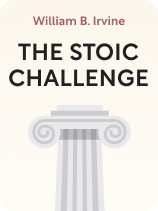

This article is an excerpt from the Shortform book guide to "The Stoic Challenge" by William B. Irvine. Shortform has the world's best summaries and analyses of books you should be reading.
Like this article? Sign up for a free trial here.
What’s The Stoic Challenge by William B. Irvine about? How did the Stoics face adversity?
Every one of us experiences hardship, often daily. In The Stoic Challenge, William B. Irvine argues that minimizing suffering isn’t just possible—it’s something that people have been doing since the Stoics pioneered a strategy to approach adversity as opportunity.
Read below for a brief overview of The Stoic Challenge.
The Stoic Challenge by William B. Irvine
Daily life is full of difficulty—but we need not suffer through it. So argues William B. Irvine in The Stoic Challenge, where he explains that anyone can learn to live a good life by navigating adversity with resolve and resourcefulness. Deriving his method from the Stoics, a group of ancient Greco-Roman philosophers, Irvine explains how to reframe your troubles and live with more equanimity, effectiveness, and even delight.
Irvine, who is professor emeritus of philosophy at Wright State University, explains that the Stoics trained themselves to take on obstacles as opportunities to strengthen their character. A Stoic would thereby aim to live “the good life,” or a life of inner peace and outer grace. Drawing from this school of thought, he presents a practical distillation of Stoicism’s central strategies for living well, and he explains how modern psychology supports their efficacy.
Stoicism in Brief
To begin, we’ll briefly contextualize Stoicism, according to Irvine. As he explains, Stoicism is an ancient philosophical school that developed in Greece and Rome beginning around the early third century BCE. Today, we know Stoicism largely through the teachings of three main philosophers: Marcus Aurelius, Epictetus, and Seneca.
In general, the Stoics were pragmatists who focused on withstanding life’s challenges with resolve and resourcefulness. They believed that you should try to control only what’s within your power—your beliefs, attitudes, and choices—and let go of everything else.
Irvine says that the Stoics perceived adversity not as a setback, but as a training ground, an opportunity for growth. They believed that the highest good was virtue—which comprises character traits like courage, honesty, and patience—and that they could become virtuous by confronting hardships.
Adversity Defines Our Lives
In this section, we’ll explain Irvine’s take on adversity—what it is, how we typically respond to it, and why those responses don’t work.
We All Experience Adversity
According to Irvine, our lives are defined by the constant presence of one thing: adversity. It affects us all and takes on numerous forms, from spilled coffee and stressful deadlines to the loss of a loved one or a failure to graduate from university.
The key feature of such adversities, Irvine says, is that we can’t always see them coming or prepare for them. Troubling events ranging from mundane daily challenges to significant, life-upending events are often unpredictable. Further, they have a variety of sources:
- We cause ourselves trouble, such as by failing to anticipate obstacles (for instance, a freak blizzard in April) or behaving in ways that create difficulty (such as by living in a messy, disorganized house).
- Other people cause us trouble, such as by getting into arguments with us, disrupting our plans, annoying us, or making choices that hurt our livelihoods or well-being.
- The natural world causes trouble, such as when the weather causes the power to go out or, more seriously, when the crops fail or a hurricane devastates your home.
We Handle Adversity Poorly by Default
Though our lives are filled with adversity, Irvine contends that by default, most people aren’t good at handling it. When some trouble comes along, people typically respond by getting upset. This can take a variety of forms, ranging from fear and anxiety to frustration, anger, or outright avoidance of the problem and how they feel. For example, if someone loses his wallet in a busy part of the city, he might react by fretting about someone stealing his cash or feeling angry about this unexpected inconvenience.
According to Irvine, each of these reactions to adversity is a different way of externalizing the problem: We look for something outside of ourselves to blame. If someone is fearful or anxious, he might feel victimized—“why me, why does life do this to me?” If he’s instead frustrated or angry, he might feel attacked or targeted by misfortune—“I don’t deserve this. This is unfair!” In either case, Irvine says, these are ineffective responses to adversity:
- When you get angry, you harm yourself and those around you. Anger clouds your mind, making it difficult to solve the problem and, at the same time, putting you into a state of acute distress that can spread to others.
- When you grow fearful, you shrink away from effective action and hide within your comfort zone. You never learn to face life’s challenges and thereby grow small, less resilient, and weak of character.
As to more significant adversity, Irvine says that in the aftermath of real loss (such as the death of a loved one or the end of a romantic relationship), we often get too wrapped up in our grieving. Traditionally, the Stoics acknowledged a small amount of grief as necessary but argued that any more came from self-centered guilt and a desire to make your sadness known so that others would comfort you. Further, Irvine says that grief counseling can undermine your resilience by coddling you when you could instead be growing tougher.
The Stoic Response to Adversity
Having set the stage, we’ll next explain the Stoics’ core strategy of treating adversities as tests of character. We’ll detail their view and their method, and we’ll discuss how Stoicism makes use of two psychological phenomena (the anchoring effect and framing) to change your relationship to hardship.
How the Stoics Handled Adversity
Though we might handle adversity poorly by default, Irvine argues that anyone can learn to navigate her troubles more effectively. You can begin to do so by understanding two Stoic insights:
- Most things are out of our control. Other people, the weather, society, the world’s governmental and economic systems, the natural world—no single person has power over these things.
- How we respond to the world is in our control. While we can’t stop storms, wars, or social disasters at work, we can control how we respond to these events.
So instead of reacting poorly when adversity comes along, a Stoic would choose to consciously respond—first, by using a mental technique to bypass and defuse their reactive emotions, and then by looking for ways to overcome the problem. This strategy served the main aim of a Stoic’s life, which, according to Irvine, was to create and maintain inner tranquility.
According to Irvine, the Stoics’ key mental technique was simply to reframe the problem. That is, upon encountering a problem or obstacle, a Stoic would choose to view it as an opportunity to practice his Stoic virtues—resilience, resolve, resourcefulness, courage, and good humor. Doing this would improve both his psychological and practical responses to adversity:
- Psychologically, he would maintain emotional equanimity (or resolve) by choosing to respond rather than react to the problem. He would aim to prevent the arising of negative emotions like anger, frustration, or cowardice.
- Practically, greater resolve would afford him a clear mind with which to solve the problem, demonstrating his resourcefulness.
After reframing a problem, Irvine says, a Stoic would look for a resourceful way to solve it. This boils down to using your clear mind to find creative solutions, though Irvine doesn’t say exactly how to do so.
Why the Stoic Strategy Works
According to Irvine, this Stoic strategy for navigating adversity works by making use of one powerful psychological phenomenon: the framing effect. In short, this effect says that the way you interpret or frame something affects how you feel about it and, in turn, how you handle it. This is because different frames emphasize different aspects of a situation, and focusing on one aspect versus another changes how you relate to it.
For instance, perhaps you had to take physical fitness assessments as a child in school, including a running test. While some kids focus on how long and physically demanding the test is, others view it as a fun way to compete with friends and beat their previous times. Just by emphasizing different aspects of the run, each group experiences the same thing in different ways.
When it comes to more serious adversities, reframing can help you see a perceived problem as a chance to grow or even enjoy yourself. In a Stoic context, that’s the whole point of reframing: It helps you view and handle troubles in a way that bolsters your emotional tranquility and improves your practical outcomes.
How to Use the Stoic Reframing Strategy Today
Traditionally, Irvine explains, the Stoics would frame the adversities they encountered as tests put to them by the Roman head god, Jupiter. They believed that Jupiter showed his favor by testing people he thought capable of achieving excellence—so every adversity was an opportunity to prove your mettle. This framing gave a Stoic the strength to remain resolute and resourceful because he wouldn’t accept failing before his god.
Although the ancient Stoic mindset relied on belief in Jupiter, their method of approaching adversity doesn’t—it’s still valid, according to modern psychology. To use this method today, then, just find a different way to frame things that reproduces the motivation that the Jupiter frame gave the Stoics. Irvine offers two alternatives:
- If you follow Christianity, Islam, or Judaism, you can devise a frame that motivates you to prove yourself in the eyes of your god.
- If you follow no god or gods, you can assume that imaginary Stoic gods will test you. Irvine contends that while it may sound silly, this has a powerful motivating effect on the subconscious, and it’s the framing that he personally uses.
In any case, Irvine says, you can then use the general form of the Stoics’ strategy: When adversity arises, immediately reframe the situation, and then attend to your emotional and practical responses to the problem.
Your emotional response is your first priority, according to Irvine. To prevent your reactive emotions from taking over, you must reframe things within five seconds. As we explained earlier, the key is to prevent negative emotions from arising in the first place.
Irvine says that once you’ve attended to your emotional response, you can focus on your practical response by looking for a way to overcome the problem.
Over time, Irvine says, practicing this strategy will condition you to feel less frustration or anger when troubles come along. It’ll become habitual to maintain your tranquility and solve your problems, and your instinct to react emotionally will weaken over time. You might even begin to look forward to adversities—and that’s a sign that you’re well on the road to Stoic-style success.
Practice and Apply the Stoic Strategy
Having discussed the Stoics’ strategy, how it works psychologically, and how you can use it today, we’ll now turn to implementing it in daily life:
- To begin, we’ll explain how you can practice the strategy in advance so that you’re prepared for real-world adversities.
- We’ll then detail how, according to Irvine, you can apply it to three key types of adversity—failure, reversals of fortune, and death—in order to live a better life today.
Train Yourself to Use the Stoic Strategy
We’ll first discuss two methods of training you can use to practice the Stoic strategy before you actually need it. Both training methods involve actively seeking out opportunities to use the Stoic strategy, and they’ll help you develop resolve and resourcefulness.
Expose Yourself to Unpredictable Adversities
Irvine’s first recommendation is to prepare for real-world setbacks by putting yourself in positions that will probably confront you with unpredictable adversities. If they come along, you have the chance to practice handling the situation as a Stoic would—reframe it as a test, diffuse negative emotions, and find a solution. The point of this training is to get used to the unpredictability of troubles and the task of remembering your strategy, since in normal life, you won’t see adversities coming.
To expose yourself to unpredictable adversities, Irvine says that you should find opportunities to challenge yourself. This could be simple and mundane, like riding your bike to work instead of driving (forcing you to navigate unforeseen troubles along the way) or more ambitious, like learning a difficult new skill. Whatever you choose, it shouldn’t take you too far outside your comfort zone. So if you’re someone who, for instance, doesn’t hike, you’d start with a local forest trail rather than a days-long alpine trek.
According to Irvine, building a new skill is the best kind of challenge you can take on because to learn any skill means navigating numerous unforeseen challenges. This is especially true if you pick a skill that relies on capacities you aren’t strong in—for instance, a powerlifter would likely experience more unpredictable adversities in learning childcare skills than he would from switching to CrossFit.
When you start to challenge yourself, Irvine says that you’ll come face to face with an internal instinct to be lazy. While this impulse exists in all of us, he recommends following the Stoic example and exerting control over it. That is, encountering your inner laziness is a signal to bolster your willpower and lean into the challenge rather than retreat from it. By persistently striving past the discomfort and the pull to take it easy, you’ll assert self-dominance and, in the process, amplify your autonomy.
Over time, opting to keep pushing when the going gets tough will develop your resolve—that is, you’ll get grittier. You’ll become more steadfast in the face of tough challenges, and you’ll get in the habit of not letting your inner laziness control your choices.
Seek Out Direct Discomfort
Irvine also recommends that you undergo training that expands your comfort zone. Whereas the challenge-based training above has you seeking possible adversity, this training involves going out of your way to get uncomfortable. In this case, the adversities won’t be unexpected (you’ll train for that as above) but rather intense and challenging.
Irvine explains that actively seeking adversity will expand your comfort zone, empowering you to remain tranquil and even experience delight in a wider range of circumstances. The greater the levels of intensity you can get used to, the better equipped you’ll be to handle intense, real-world adversities. This training has two dimensions: emotional toughening and physical toughening.
Emotional toughening is when you practice facing your fears in order to expand your comfort zone. Irvine recommends that you gradually expose yourself to what you’re afraid of (such as handling dogs) and intensify the challenge over time.
Physical toughening is when you train your body by exposing yourself to increasingly intense physical stressors. Irvine suggests extreme temperature training, physical exercise, dieting and fasting, and endurance training.
Irvine explains that an added benefit of training in these ways is that the Stoics would experience greater pleasure from lesser indulgence. That is, toughening yourself up with Stoic-style training—living in bare, austere conditions and seeking out challenges—has the side effect of making worldly pleasures seem all the more wonderful if they happen to come along.
In contrast, people who constantly indulge grow used to pleasure and thereby lose their ability to enjoy it. They become so physically and emotionally soft that even slight discomfort will seem unbearable. According to Irvine, this implies that in the long run, intentionally seeking and getting used to discomfort reduces it better than avoiding it does.
Approach Key Adversities Like a Stoic
Now that we’ve covered how to train like a Stoic, we’ll pivot to Irvine’s discussion of three key areas of life in which you can apply this training. Namely, we’ll discuss how to approach failure, falls from high places, and death as a Stoic would.
Approach Failure as an Opportunity to Learn
Irvine suggests that you use the Stoics’ method of reframing to improve your relationship to failure. Specifically, he suggests that you reframe failures—which most of us perceive and thereby experience as adverse events—as learning opportunities.
If you never acknowledge your mistakes and failures, Irvine argues, you’ll never learn anything. This is because our failures show us exactly what we did wrong and, in this way, suggest what we need to do differently to improve the next time around. Failure, then, is profoundly useful. In fact, it’s a core ingredient of success. According to Irvine, anyone who achieves anything of note does so not in spite of failure, but because they learn from their failures. This is true of world-class athletes, entrepreneurs who change the world, parents who raise good humans, professional musicians, and anyone else who’s succeeded.
Irvine recommends that to embrace failure, you should break your goals into actionable steps and anticipatable obstacles. Then, take action, make mistakes, learn from them, and push ahead. You’ll either succeed or fall short having learned a lot. And if you fail, don’t worry—it’s better to have tried and failed than to have never tried at all.
Approach the Loss of Good Fortune With Grace and Humility
Next, Irvine turns to what he calls a particularly pernicious form of adversity—when things are going well, you’re high on success and good fortune, and then suddenly everything takes a catastrophic turn.
The Stoics noticed this phenomenon and would practice humility as a way to allay the risk of such catastrophic reversals of fortune. According to Irvine, any extended period of good fortune tends to lead into a particularly brutal or unexpected misfortune. To avoid this, he recommends that you do as the Stoics did: Take good fortune in stride and stay humble. More specifically, enjoy it without announcing your joy to the world. Doing so can attract envy; and envious peers, Irvine says, are the most common source of reversals of fortune. Such people will try to sabotage or ruin your good times, like a workplace colleague who’s jealous of your recent promotion.
Approach Death as the Final Stoic Test
Last, Irvine turns his attention to how the Stoics approached death. He says that today, we typically ignore the reality of death. We sweep it under the rug or operate on naive childhood understandings of death as leading to a happy afterlife. And because we ignore our inevitable deaths, we never realize the true value of our lives.
According to Irvine, the Stoics related to death differently. First, they actively practiced acknowledging human mortality in order to better appreciate their lives in the present. They did this with a variety of techniques that involve briefly thinking about worst-case scenarios. This makes use of the anchoring effect, a psychological phenomenon wherein priming yourself with a reference point helps you see something in a new light. The Stoics’ techniques include:
- Realizing that this could be the last time you’re doing something—be it cooking a meal, hugging your best friend, or sitting down to work.
- Contemplating that someday in the future, you’ll likely wish you could return to this present moment—to an old and enfeebled version of yourself, earlier life could seem a wonderland.
Both of these techniques help you candidly see the reality of your eventual death and thereby appreciate your life more now. This may seem paradoxical, but knowing deeply that you’ll one day die can bring you more fully into living your life today.

———End of Preview———
Like what you just read? Read the rest of the world's best book summary and analysis of William B. Irvine's "The Stoic Challenge" at Shortform.
Here's what you'll find in our full The Stoic Challenge summary:
- How you can minimize suffering by reframing it
- How you can use the Stoics’ strategy in your everyday life
- Why you should take any good fortune in stride






